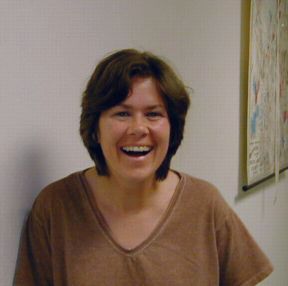|
|
|
 Sidney
Hemming: Assistant Professor, Dept. of Earth & Environmental Sciences
Sidney
Hemming: Assistant Professor, Dept. of Earth & Environmental Sciences
Lamont-Doherty Earth Observatory
61 Route 9W
Palisades, NY 10964(845) 365-8417
 Research
Interest
Research
Interest
In addition to conventional applications of the 40Ar/39Ar system for geochronological studies, I am interesting in applying this method to tracing sediment sources. The compositions of terrigenous sediments are set by the composition, age and geological history of their sources. Accordingly provenance studies on well selected samples can provide important constraints on our knowledge of past wind patterns, sea ice cover, iceberg activity, and bottom and surface currents. Below I describe two general applications using the LDEO Ar lab.
Ice rafting was an important depositional process in the North Atlantic during glacial cycles of the Pleistocene. The distribution of ice rafted detritus in the North Atlantic has been used to infer the major sources of icebergs and the general pattern of surface circulation, and has confirmed a similar pattern for glacial and interglacial times with a southward shift in the locus of melting related to colder surface water in glacial times. Heinrich layers have gained prominence due to their particular richness in ice rafted detritus and paucity of foraminifera which make them easy to recognize. They are also intriguing and significant because of their strong ties to regional and perhaps global abrupt climate changes. We have applied multiple isotopic tracers, including 40Ar/39Ar dating of individual hornblende, biotite and feldspar grains, to identify the sources of icebergs during the last glacial cycle. We are working to characterize important point sources, and to extend the records back in time, as well as to high resolution in some key intervals. These data will be used to constrain models of ocean-climate-ice interactions.
As a member of the CORC (Consortium for the Ocean's Role in Climate), my role is to use radiogenic isotopes to trace detrital and authigenic sediment sources. 87Sr/86Sr of detritus and 143Nd/144Nd of the ferromanganese fraction have proved particularly useful for identifying currents and North Atlantic Deep Water contributions to the southeastern Atlantic. Recently, we have been calibrating and testing the application of tracing fine-grained sediments by measuring their radiogenic Ar (40Ar*) contents. The 40Ar* concentrations are proving useful as terrigenous sediment tracers, and we have four ongoing applications of this method: 1) identification of Heinrich layers in previous glacial intervals- was this distinctive source unique to the last glacial cycle?; 2) characterizing the compositions of Arctic shelf sediments- sea ice carries fine sediments from shelf areas around the Arctic Ocean. Our goal is to use the compositional information from the shelves to track the sources and paths of sea ice circulation in the Arctic Ocean; 3) tracing terrigenous sediment sources in the South Atlantic with particular emphasis on examining past changes in the strength of the Agulhas leakage; 4) Interplanetary Dust Particles (IDP's) have high 3He concentrations, and can thus be treated as a natural spike to measure sediment flux. One assumption is the composition of the terrigenous end-member, and this composition varies with geological provenance. As a second noble gas with only terrigenous sources, the 40Ar* concentration may provide a key means of constraining the composition of the terrigenous end-member for 3He/4He studies of sediment flux.
 Selected
Publications
Selected
Publications
Hemming, S. R., Bond, G. C., Broecker, W. S., Sharp, W. D., and Klas-Mendelson, M., Evidence from 40Ar/39Ar Ages of individual hornblende grains for varying Laurentide sources of iceberg discharges 22,000 to 10,500 14C yr B.P., Quaternary Research, in press (Nov. 2000 issue).
Rutberg, R. L., Hemming, S. R., and Goldstein, S. L., Reduced North Atlantic Deep Water flux to the glacial Southern Ocean inferred from neodymium isotope ratios, Nature, 405, 935-938, 2000.
Hemming, S. R., Gwiazda, R. H., Andrews, J. T., Broecker, W. S., Jennings, A. E., and Onstott, T., 40Ar/39Ar and Pb-Pb study of individual hornblende and feldspar grains from southeastern Baffin Island glacial sediments: implications for the provenance of the Heinrich layers, Canadian Journal of Earth Sciences, 37, 879-890, 2000.
Hemming, S. R., and Rasbury, E. T., Pb isotope measurements of sanidine monitor standards: implications for provenance analysis and tephrochronology, Chemical Geology 165, 331-337, 2000.
Hemming, S. R., Broecker, W. S., Sharp, W. D., Bond, G. C., Gwiazda, R. H., McManus, J. F., Klas, M., and Hajdas, I., Provenance of Heinrich layers in core V28-82, northeastern Atlantic: 40Ar/39Ar ages of ice-rafted hornblende, Pb isotopes in feldspar grains, and Nd-Sr-Pb isotopes in the fine sediment fraction, Earth and Planetary Science Letters, 164, 317-333, 1998.
Hemming, S. R., Biscaye, P. E., and Broecker, W. S., Provenance change coupled with increased clay flux during deglacial times in the western equatorial Atlantic, Palaeogeography, Palaeoclimatology, Palaeoecology, 142, 217-230, 1998.
